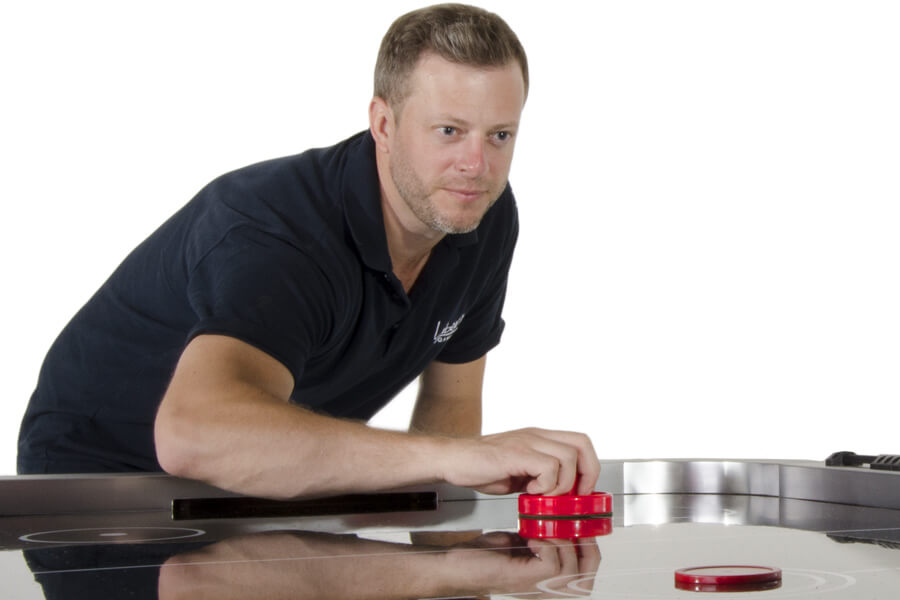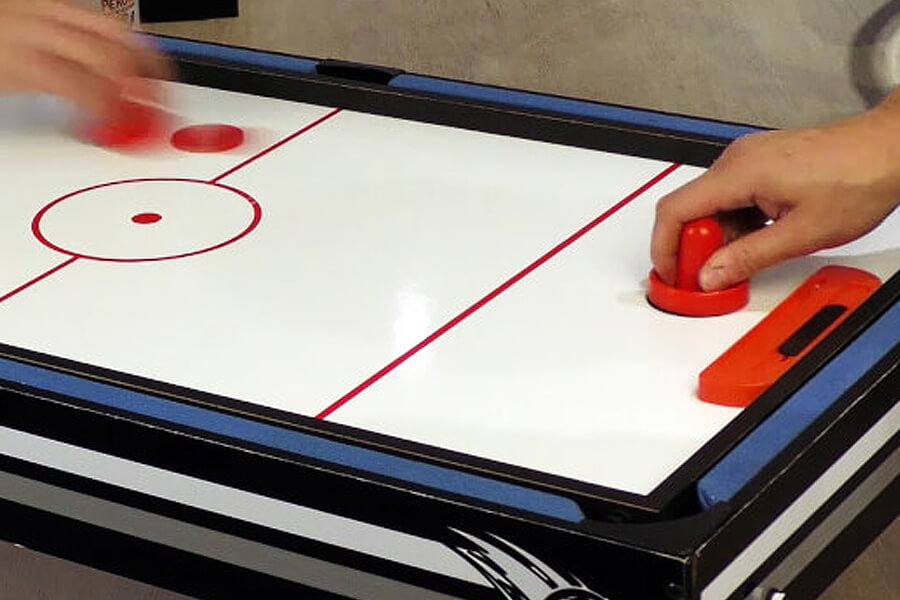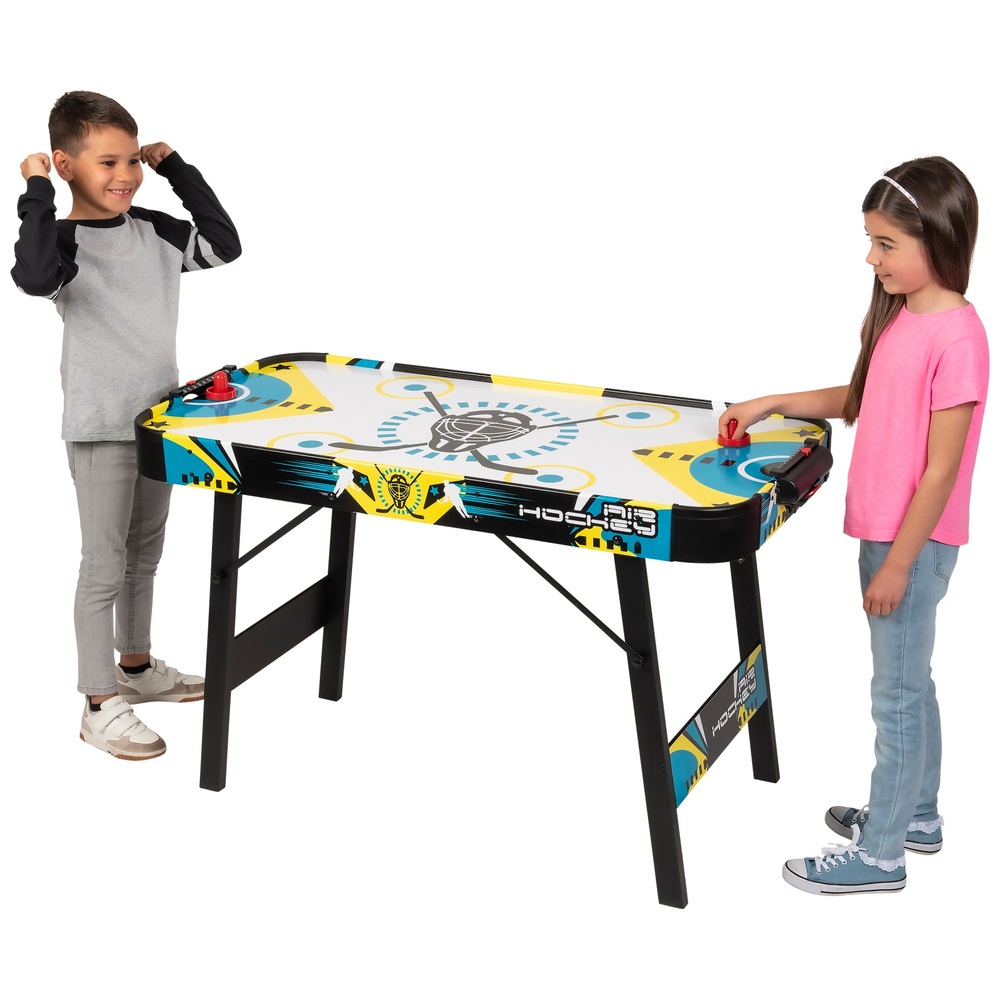How Do Air Hockey Tables Work? Navigating The Glide
Explore the captivating mechanics behind the exhilarating game of air hockey. From the precision-engineered air cushion system that defies friction to the purposeful design of the puck and the strategic construction of the table, uncover the secrets of how do air hockey tables work.
Author:James DavisNov 16, 202337.7K Shares698.5K Views

Air hockey tables are a popular and entertaining game that can be found in arcades, game rooms, and even in some homes. How do air hockey tables work?
The game involves two players using handheld paddles to hit a puck back and forth across a specially designed table. The key element that sets air hockey apart from traditional tabletop games is the cushion of air that allows the puck to glide smoothly across the surface.
Everyone can enjoy themselves with an air hockey table, regardless of age, gender, or athletic ability. It's simple to play, thrilling, and enjoyable. So how do pucks skate over the board like magic on these tables? The ability of air hockey tables to float is due to a very basic setup.
Compared to other gaming tables like pool tables and shuffle boards, air hockey tables are a relatively new creation, having been created by a group of engineers in the early 1970s. The game gained popularity fast, and numerous leagues and competitions soon followed.
So, how do air hockey tables work? Generally, the low-friction playing surface, specialized equipment, and air cushion all work together to create an effective air hockey table. A thin layer of air is created by the air cushion between the puck and the playing surface when the puck is put into play, which lowers friction and permits the puck to move smoothly.
Only the appearance and technology of the tables have changed over time, keeping the essential concept unchanged into the present era. It is now recognized as a sport in the United States, where the United States Air-Table Hockey Association (USAA) judges formal competitions that take place every year.
Although air hockey isn't a recognized sport outside of the United States, commercial air hockey tables are a common sight at bars, amusement arcades, and other establishments, and home air hockey tables are becoming a more and more popular addition to personal gaming rooms.
Let's delve into the details of how air hockey tables work.
Table Construction In Air Hockey Tables
Air hockey tables are engineered with precision to provide a smooth and durable playing surface. The construction of the table is a crucial aspect that contributes to the overall gaming experience. Here's an in-depth look at the elements involved in the table construction:
- Playing Surface Material -The playing surface of an air hockey table is typically constructed using high-density fiberboard (HDF) or medium-density fiberboard (MDF). These materials are chosen for their durability and stability. The surface is crafted to be perfectly level to ensure fair gameplay.
- Friction-Reducing Coating- To facilitate the effortless movement of the puck, the playing surface is coated with a friction-reducing material. High-pressure laminate is commonly used for this purpose. This coating minimizes resistance, allowing the puck to glide smoothly across the table.
- Rails and Cushioning Materials -The perimeter of the playing surface is surrounded by rails. These rails are essential for keeping the puck in play and adding an element of strategy to the game. Often, the rails are lined with cushioning materials such as rubber or foam. This not only helps in rebounding the puck but also reduces the impact noise during gameplay.
- Goal Openings:At either end of the table, there are goal openings where players attempt to score points. These goal areas are strategically positioned, and their dimensions comply with standard air hockey regulations. The goal openings contribute to the competitive nature of the game.
- Puck Return System -To maintain the flow of the game, air hockey tables are equipped with a puck return system. After a goal is scored, this system ensures that the puck quickly returns to the center of the table, ready for the next round. It adds efficiency to the gameplay, minimizing downtime between goals.
The Air Cushion System In Air Hockey Tables
The hallmark of air hockey tables is the air cushion system, a technological marvel that revolutionizes the way the game is played. This system creates a frictionless environment, allowing the puck to float on a cushion of air.
At the core of the air cushion system is a powerful electric motor. This motor is responsible for driving a fan that draws in air from the surrounding environment. The force generated by the fan is crucial in creating the continuous stream of air required for the game.
Beneath the playing surface, there is an intricate network of thousands of tiny holes. These holes are strategically placed to cover the entire surface evenly. The role of these holes is to release the steady stream of air that forms the cushion on which the puck glides.
The air released through the holes serves a dual purpose. Firstly, it lifts the puck slightly off the playing surface, reducing the friction between the puck and the table. This reduction in friction enables the puck to move with incredible speed and responsiveness.
The distribution of air is carefully calibrated to maintain a consistent airflow across the entire table. This uniformity ensures that the puck experiences minimal resistance, creating a level playing field for both players.
Some advanced air hockey tables come with features that allow players to adjust the airflow. This customization can cater to different skill levels and preferences, providing a more personalized gaming experience.
Regular maintenance is crucial to keep the air cushion system in optimal condition. This involves checking the motor, fan, and air holes for any obstructions. Clearing these components ensures a steady and even flow of air during gameplay.
Understanding the intricate details of table construction and the air cushion system sheds light on why air hockey tables provide such a thrilling and dynamic gaming experience. The synergy between the materials used, the design elements, and the technological innovations creates an environment where players can showcase their skills and immerse themselves in the excitement of air hockey.
Puck Design In Air Hockey Tables
The design of the air hockey puck is a critical element that directly influences the game's speed, responsiveness, and overall excitement. A well-crafted puck enhances the player experience and ensures a dynamic and engaging game. Here's a detailed exploration of the key aspects of puck design in air hockey:
- Flat and Round Shape -Air hockey pucks are intentionally designed with a flat and round shape. This distinctive form minimizes the surface area in contact with the table, reducing friction and allowing the puck to glide effortlessly. The flat profile also contributes to the puck's stability during high-speed movements.
- Low Profile -The puck has a low profile, ensuring that it hovers just above the playing surface. This low clearance minimizes the air gap between the puck and the table, promoting a close and responsive interaction. The low profile also adds to the puck's aerodynamic efficiency, allowing it to maneuver swiftly.
- Symmetrical Openings -The bottom of the puck is designed with small, symmetrical openings. These openings serve a dual purpose: they allow air to escape, creating lift, and they reduce air resistance. The combination of these factors ensures that the puck remains buoyant and responsive to player actions.
- Material Composition -Air hockey pucks are typically made of durable and smooth materials such as plastic. The choice of materials is crucial to maintaining the puck's integrity over time and ensuring consistent performance. High-quality pucks are resistant to wear and can withstand the rigors of high-speed gameplay.
Player Equipment In Air Hockey Tables
The equipment used by players in air hockey, namely the paddles or strikers, plays a crucial role in the game's dynamics. The design and characteristics of player equipment directly impact control, precision, and overall player experience. Here's an in-depth exploration of player equipment in air hockey:
- Handheld Paddles (Strikers/Mallets) -Players use handheld paddles, also known as strikers or mallets, to hit the puck during gameplay. These paddles are typically made of lightweight materials, allowing players to maneuver them swiftly across the table. The design of the paddles is streamlined to minimize air resistance and enhance control.
- Smooth Bottom Surface -The bottom surface of air hockey paddles is intentionally smooth. This design choice reduces friction between the paddle and the puck, ensuring that players can execute rapid and precise movements. The smooth surface allows for seamless interactions with the puck during both offensive and defensive plays.
- Ergonomic Design -Paddle design often incorporates ergonomic considerations to enhance player comfort and control. The handles are shaped to fit comfortably in the player's hand, allowing for extended gameplay without discomfort. Ergonomics play a crucial role, especially in competitive settings where players engage in prolonged matches.
- Materials and Construction -Common materials for paddle construction include plastic, wood, or a combination of materials. The choice of materials affects the paddle's weight, durability, and overall feel. High-quality materials ensure that the paddles can withstand the impact of the puck and maintain their structural integrity over time.
- Size and Weight -Air hockey paddles come in various sizes and weights to accommodate different player preferences. Some players prefer lightweight paddles for increased maneuverability, while others may opt for slightly heavier paddles for added stability during shots. Customization in size and weight allows players to tailor their equipment to their playing style.
- Electronic Features (Optional) -Advanced air hockey tables may feature electronic components within the paddles. This can include sensors for scoring purposes or even built-in scoring displays. Paddles with electronic features add a layer of sophistication to the game, providing players with real-time feedback on their performance.
- Grips and Surface Texture -The grips on air hockey paddles often have a textured surface to enhance control. The texture provides additional grip, allowing players to maintain better control over the paddle's movements. This becomes especially crucial during intense and fast-paced moments in the game.
- Paddle Maintenance -Regular maintenance of air hockey paddles is essential to ensure optimal performance. Cleaning the paddles, checking for any damage, and ensuring the smoothness of the bottom surface contribute to consistent gameplay. Paddle maintenance is often a part of the overall care routine for air hockey tables.
Game Dynamics In Air Hockey Tables
The game dynamics of air hockey contribute significantly to the fast-paced and exhilarating experience that players enjoy. Several elements shape the dynamics of the game:
- Puck Movement -The frictionless environment created by the air cushion system allows the puck to move with incredible speed and responsiveness. The puck can bounce off the walls and change direction rapidly, adding an element of unpredictability to the game. This dynamic movement requires players to stay alert and respond quickly to changes in puck trajectory.
- Player Reflexes -Success in air hockey is closely tied to the reflexes of the players. The rapid back-and-forth movement of the puck demands quick reactions and precise hand-eye coordination. Players must be ready to block shots from their opponent while simultaneously planning their offensive moves.
- Scoring Strategies:Scoring in air hockey involves shooting the puck into the opponent's goal. Players must balance offensive and defensive strategies, finding the right moment to strike and the right moment to defend. The game dynamics encourage strategic thinking and split-second decision-making.
- Bouncing and Rebounding -The interaction between the puck and the rails adds an extra layer of complexity to the game. The puck can bounce off the rails in unexpected ways, requiring players to anticipate and adapt to the changing trajectory. Mastering the art of using the rails to your advantage is a key aspect of advanced gameplay.
- Competitive Intensity -Air hockey is known for its competitive intensity. The fast-paced nature of the game keeps players engaged, and the close proximity of the goals means that a lead can change rapidly. This competitiveness adds to the thrill of the game, making it a popular choice for both casual and serious players.
Maintenance Of Air Hockey Tables
Proper maintenance is crucial to ensuring the longevity and optimal performance of air hockey tables. Regular upkeep involves attention to various components:
- Cleaning the Playing Surface -The playing surface should be kept clean and free of dust or debris. Any buildup on the surface can affect the movement of the puck and disrupt the smooth gameplay. Regular cleaning with a non-abrasive cloth helps maintain the quality of the playing surface.
- Air Blower System Check -The motor-driven fan and the air holes in the playing surface are integral to the air cushion system. Regular checks should be conducted to ensure that the fan is functioning correctly and that there are no obstructions in the air holes. Any issues with the air blower system should be addressed promptly.
- Paddle and Puck Maintenance -The paddles and pucks used in air hockey can accumulate dirt and wear over time. Cleaning the paddles and ensuring the puck's surface is smooth is essential for consistent gameplay. Paddles with electronic components, such as scoring sensors, should be checked for proper functioning.
- Goal Mechanism Inspection -The goal openings and the puck return system should be inspected regularly. Make sure the goals are free of any blockages, and the puck return system is working smoothly. This ensures that the game continues without interruptions.
- Adjusting Airflow if Necessary -Some air hockey tables come with adjustable airflow settings. Depending on player preferences or skill levels, the airflow can be adjusted for a more customized experience. Regularly checking and, if needed, adjusting the airflow contributes to optimal gameplay.
How Do Air Hockey Tables Work? - FAQs
How Does The Air Hockey Table Create The Cushion Of Air?
The air hockey table generates the cushion of air through a motor-driven fan located beneath the playing surface. This fan propels a steady stream of air through tiny holes, creating the frictionless surface on which the puck glides.
What Materials Are Commonly Used For The Playing Surface Of Air Hockey Tables?
Air hockey tables typically have a playing surface made of high-density fiberboard (HDF) or medium-density fiberboard (MDF). This surface is coated with a friction-reducing material to ensure smooth puck movement.
How Does The Design Of The Air Hockey Puck Contribute To Its Performance?
The air hockey puck is designed with a flat, round shape and a low profile. It has small, symmetrical openings on the bottom to allow air to escape, creating lift and reducing air resistance for optimal gliding on the playing surface.
What Role Do The Rails Play In Air Hockey?
The rails on an air hockey table serve to keep the puck in play by providing bounce. They are typically lined with cushioning materials like rubber or foam to ensure that the puck remains in motion and adds an element of strategy to the game.
What Skills Are Important For Success In Air Hockey?
Success in air hockey requires quick reflexes, precision, and a good understanding of both offensive and defensive strategies. Players must be adept at controlling the puck, blocking shots, and scoring goals to excel in the game.
Conclusion
How do air hockey tables work? Air hockey tables captivate players with their unique combination of a frictionless playing surface and fast-paced gameplay. The air cushion system, propelled by a powerful motor, allows the puck to glide effortlessly, creating an exhilarating experience for players of all skill levels.
As a social and competitive game, air hockey continues to be a favorite in arcades, game rooms, and homes around the world. Whether you're a casual player or a seasoned competitor, the joy of sending the puck flying across the table remains a timeless aspect of this beloved game.

James Davis
Author
James Davis keeps you updated daily with the best shopping tricks, hacks, and frugal living tips that you won’t find anywhere else. He also talks and writes about creative ways to save money, job opportunities like clever ways to make money from home, great jobs for teens, and online jobs that pay well.
James also enjoys working on Social Media campaigns for major brands. He believes in creating a personal relationship between the brand and its consumers. He is very much into taking the corporate out of the brand and bringing it down to the level where consumers can feel comfortable interacting and taking the brand seriously.
Latest Articles
Popular Articles

